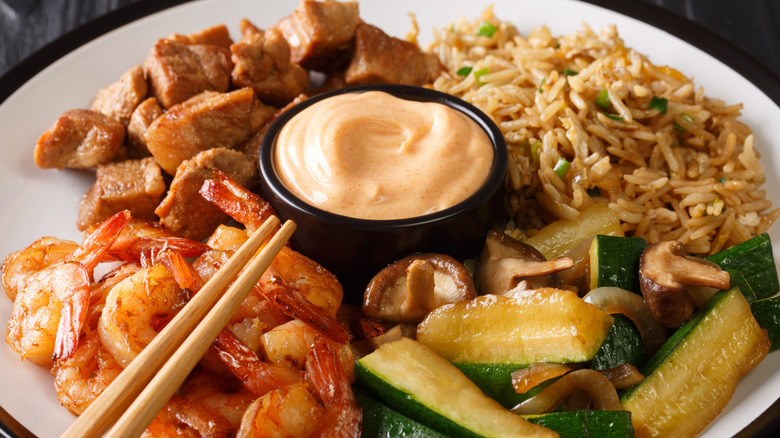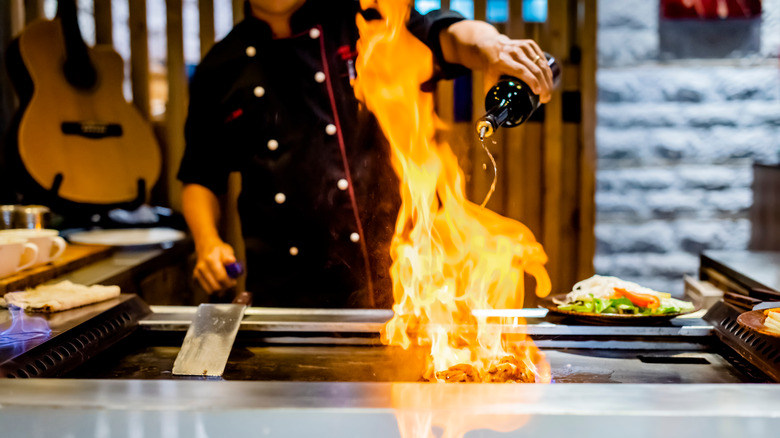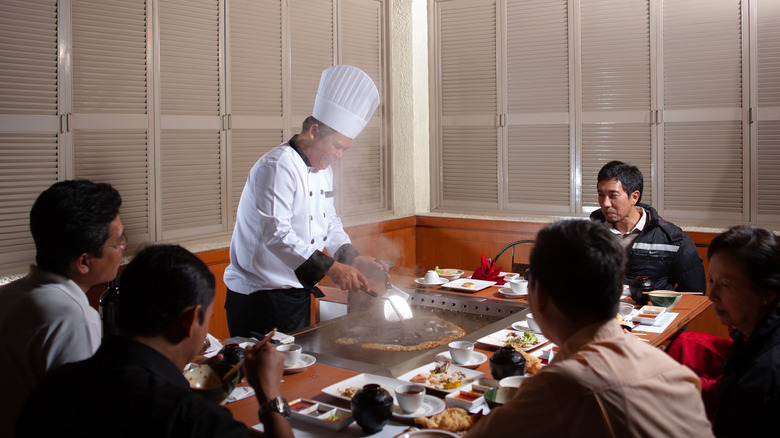Hibachi Dining: What To Expect And How To Behave
Hibachi dining in America has come to be equated with dinner and a show, and rightfully so. After all, your dinner is cooked right before your eyes by a chef in a very tall hat who prepares and cooks your food, all while flipping razor sharp knives, igniting onion volcanos, and tossing shrimp tails on top of said hat with ease. Despite the fact that most people misinterpret Teppanyaki cooking for Hibachi cooking, both styles are Japanese specialties, ones in which groups of people gather around a large cooking vessel where a chef comfortable with pyrotechnic techniques shines.
The theatrics that take place naturally spark conversation, applause, and a general uptick in human enthusiasm, which is why many "oohs” and "ahhs" are common sounds in such restaurants on any given evening. While the energy is expected and enlivening, it's important to remember that manners should not fly out the window. You should always keep your elbows off the table and chew with your mouth closed, but there are also some rules of etiquette specific to hibachi restaurants. Will breaking them get you banned for life? Probably not. But following them could earn you the respect of the chef.
What to expect
If you're new to Hibachi dining, the first thing you should know is you might be sitting with strangers. A typical Hibachi dining table features a large grill or griddle with numerous seats on three sides. Diners face the grill and the chef behind it. If your group is large, you may have the entire table to yourself. But if not, you will likely be seated with another party. A server will greet you, bring menus, and take your drink orders. While you can order your meal a la carte, many people take advantage of pre-set, multi-course menus, which typically include a soup, salad, steamed or fried rice, vegetables, and your choice of meat, chicken, and/or seafood. The fried rice, veggies, and meats are prepped and cooked on the griddle in front of you via sautéing and searing methods.
You can often order extra appetizers and sushi rolls, but these are usually prepared in the kitchen and will be brought out to you. As your chef cooks, they are often very theatrical, creating intentional flare ups, performing utensil gymnastics, and possibly flinging shrimp into your mouth (only if you want them to). Once they finish their cooking, they will place the food on your plate. Once everyone at the table is served, they will clean up the griddle, thank you, and move to another table. At this point, your server will wait on you for the rest of your visit.
Mind your manners
Hibachi dining is a very convivial experience. It is fun and lively and it's completely expected for you to have a good time with the people you are with. Conversation with the chef is encouraged, particularly if you're a first timer and have questions about the cooking methods or ingredients, so don't be afraid to chat. You should not talk while the chef is actively cooking, as this is a sign of respect. Yes, they are entertaining, but they are also professionals who aim to create well-cooked and delicious tasting meals for you and your group.
You should also note that as each diner's meal is cooked, the chef will often push the cooked food to the edges of the grill until everyone's meals are finished so that they can serve everybody at once. This is not an invitation for you to dig in. Don't reach towards the griddle with your chopsticks and start noshing on your filet mignon, as enticing as it looks. The chef will place every morsel of your food on your plate when they are ready to serve everyone.
You can thank your chef with applause and cheers if you'd like and once your meal is served, feel free to chat it up with your group and enjoy your evening. Overall, these are easy rules to follow and won't adversely affect your experience. In fact, they might amplify your time altogether.


